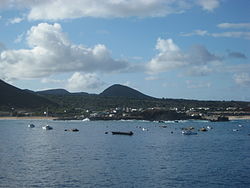Georgetown, Ascension Island
| Georgetown | |
|---|---|

Georgetown (2011)
|
|
 Map of Ascension Island showing Georgetown's location |
|
| Sovereign state | United Kingdom |
| British overseas territory |
|
| Island | Ascension Island |
| First inhabited | 1815 |
| Founded by | Royal Navy |
| Named for | King George III |
| Capital of | Ascension Island |
| Population (2008) | |
| • Total | 450 (est.) |
| Time zone | GMT (UTC+0) |
| Climate | BWh |
Georgetown is the capital and chief settlement of Ascension Island, Saint Helena, Ascension, and Tristan da Cunha, situated on the west coast of the island.
The town is centred on St Mary's Church, part of the Anglican Diocese of St Helena and the former Exiles Club, built as a Royal Marines barracks at the time of Napoleon's exile to Saint Helena in the early 19th century. The town is named after King George III, who reigned at the time the island was claimed for Britain and garrisoned by the Admiralty in 1815. As well as the church, there is a pier, an athletics track, a small supermarket, Royal Mail post office, snackbar, hotel, police station, hospital, dental surgery and a library. There is no school however and pupils travel to Two Boats village, 3 miles inland.
A naval base was established at Georgetown in 1816 due to British concerns that the French might make use of the island to attempt a rescue of their exiled former Emperor. Following Napoleon's death in 1821, the settlement found a new role as a supply, maintenance and victualling base for the West Africa Squadron. Local tufa was used for building, but everything else had to be imported (including seeds, vegetables and fruit trees, all of which were cultivated on Green Mountain to supplement the locally-available diet of turtle meat). By 1829 a small jetty had been constructed as well as several buildings on what is now the Regent Square area, close to the sea (including a hospital – the West Africa Squadron was notoriously prone to sickness).
In June 1829 a Lieutenant of the Royal Engineers, Henry Brandreth, arrived on Ascension with a remit to survey the facilities there and make recommendations for their improvement. He condemned what he found as, for the most part, 'miserable tenements ... inhabited by vermin'. Together with the local commandant, he recommended re-establishing the settlement a little way back from the sea on the elevated plateau which Georgetown occupies today. Having returned to England to oversee the supply and manufacture of certain items for the island, he returned in 1830 to begin work on this project. A key innovation was the construction of St George's Water Tank, which can still be seen today: water was channelled to it from the mountain top, as well as from every roof in Georgetown, and from here it was fed by a windpump into a header tank for distribution to local buildings (and, via a pipeline, to the pierhead for transfer to ships). The Marine Barracks building also dates from this period, as do several other buildings including Georgetown's hospital, which continues to fulfil the purpose for which it was built.
...
Wikipedia
